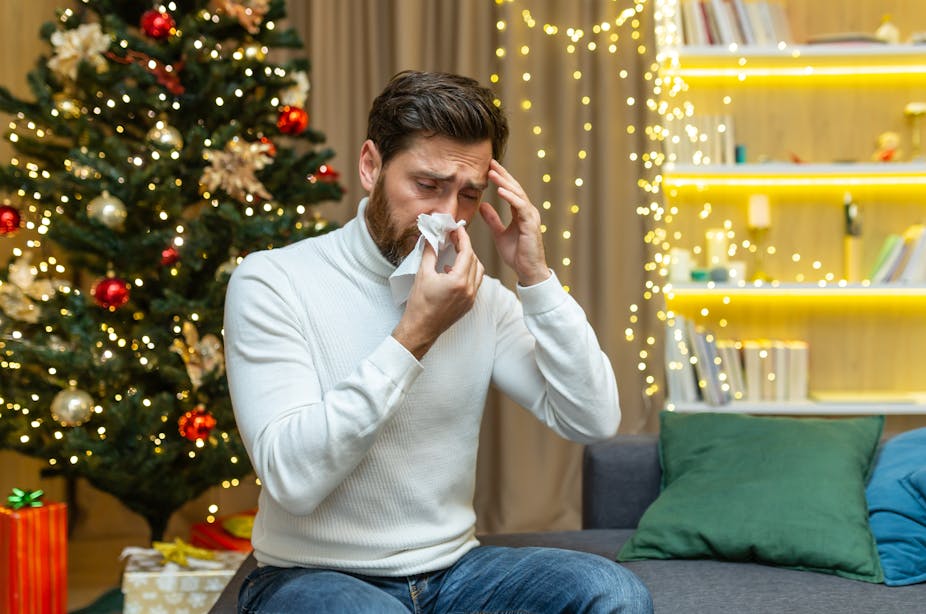Decorating the Christmas tree is a beloved tradition for many of us during the festive season. While some people prefer using and reusing an artificial tree as an environmentally friendly way to enjoy the holiday spirit, others hunt instead for the perfect real tree to adorn with ornaments and cluster presents around.
But some people who decide to get a real tree may find that after it has been decorated they begin to experience cold-like symptoms. While many may simply chalk these symptoms up to having caught a cold – or even COVID – the culprit may actually be a little-known condition called Christmas tree syndrome.
Christmas tree syndrome encompasses a spectrum of health issues triggered by exposure to the allergens residing on live Christmas trees. For those who are sensitive to allergens, prolonged exposure to live Christmas trees can lead to respiratory and skin health issues.
The main symptoms of Christmas tree syndrome include a stuffy or runny nose, sneezing, irritated eyes, coughing, wheezing and itchy throat. Asthma symptoms may also worsen. Skin-related symptoms may include redness, swelling, and itching.
This phenomenon happens thanks to the ecology of live trees, which carry microscopic entities – including pollen and fungi. Pollen, a notorious outdoor allergen, may hitch a ride into our homes, while fungi find a cosy haven in cold, damp Christmas tree farms and garden centres.
Live Christmas trees can also carry mould. Notably, a single Christmas tree can host more than 50 species of mould, creating a habitat for these tiny yet potentially troublesome organisms. Many of the mould varieties found on trees are those most likely to trigger allergies, including Aspergillus, Penicillium, and Cladosporium.
Researchers have also closely measured mould counts in rooms containing live Christmas trees. During the first three days the tree is indoors, mould spore counts measure about 800 spores per cubic meter of air. On the fourth day, however, spore counts begin rising – eventually reaching 5,000 spores per cubic meter within two weeks.

Mould grows best in warm, wet and humid conditions. So when the tree is brought indoors, the warmer climate significantly increases mould production.
Pine pollen is not a major issue for allergy-sufferers when it comes to Christmas trees. But Christmas trees can come into contact with other known allergens while they’re growing, which can then be carried into the house. For example, grass pollen can stick to the sap in a Christmas tree during the spring. Then, when the tree is harvested and brought indoors, the sap dries out, and the trapped pollen particles are released into the air.
Managing symptoms
Certain people are at higher risk of experiencing Christmas tree syndrome. People with asthma or chronic obstructive pulmonary syndrome (COPD) may be more sensitive to allergens – and these allergens may also exacerbate symptoms such as coughing and wheezing.
People who suffer from allergies are also at greater risk – with research showing 7% of allergy-sufferers experienced a spike in symptoms when they had a Christmas tree in their home. People with skin issues (such as contact dermatitis and itching) may also find that their symptoms worsen around fresh Christmas trees.
Timely recognition of symptoms is crucial to mitigate the impact of Christmas tree syndrome. So if you do suffer from allergies, here’s what you can do:
Select your tree carefully: Opt for varieties with lower allergenic potential. Fir trees, such as Douglas and Fraser, are known for producing fewer allergens compared to spruce or pine.
Inspect your tree: Conduct a meticulous inspection for signs of fungi before bringing the tree indoors. Focus on areas where moisture may accumulate, as damp conditions foster mould growth. The most common mould found on Christmas trees is Aspergillus, which will look black on the surface and usually white-ish or yellow underneath.
Proper maintenence: Regularly water live trees to prevent dehydration, as this can lead to mould growth. A well-hydrated tree is also less likely to harbour fungus. And since warm, moist environments increase mould growth, try to keep your house ventilated while it’s up. You might even consider using a dehumidifier to decrease moisture levels in your home.
Minimise direct contact: Try to avoid too much direct contact when decorating the tree. Wearing gloves might be one may of reducing the risk of skin-related reactions.
Go artificial: Consider artificial trees as a practical alternative. These eliminate the risk of allergens and can be reused – reducing their environmental impact.
Christmas tree syndrome can be a nuisance. But by considering the science and taking precautions, you can ensure an enjoyable and allergen-free festive season.

